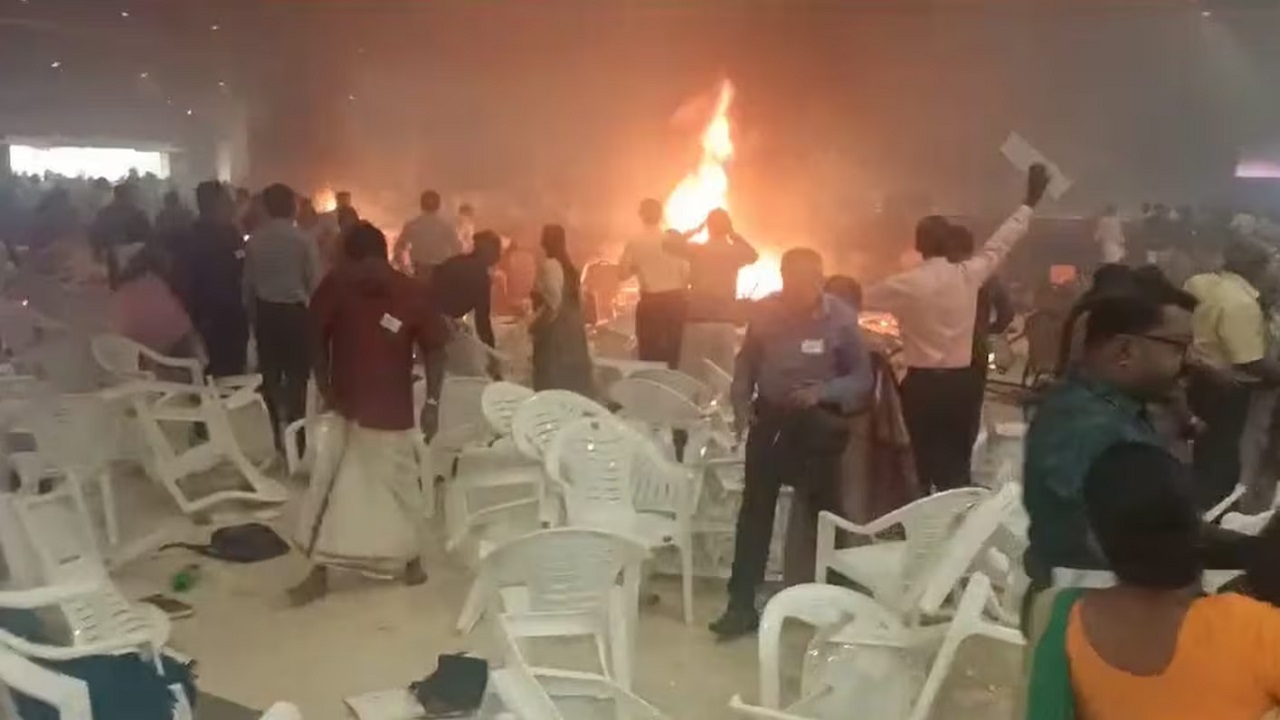
Kerala Blast

Kerala Blast
01-11-2023
Daily Current Affairs , RACE IAS : Best IAS Coaching in Lucknow
|
For Prelims: Improvised Explosive Device, Contents of IED, Use of IED in India For Mains: Components of IED, Jehovah's Witnesses, Their belief, Controversy regarding |
Why in the news?
The recent low-intensity blast at a convention center in the Kalamassery area of Kochi in Kerala, in which a congregation of Jehovah's Witnesses was targeted, is suspected to have been an Improvised Explosive Device (IED).
Important points:
- On 29 October 2023, serial blasts were carried out at a prayer meeting of Jehovah's Witnesses at the Kochi Convention Center in Kerala.
- So far, three people are estimated to have died (1 woman) and 45 people are injured due to this explosion.
- There were 2000 people present at the scene at the time of the explosion, out of which two died.
- According to preliminary investigation into the blast at a prayer meeting of Jehovah's Witnesses, an incendiary device was used to carry out the serial blasts.
- Incendiary is similar to IED, it causes a small explosion, which causes fire.
About Improvised Explosive Device (IED)
- IED is also a type of bomb, but it is different from military bombs.
- Terrorists use IEDs to cause large-scale damage.
- As soon as an IED explodes, a fire often occurs on the spot, because deadly and incendiary chemicals are used in it.
- To trigger an IED, the terrorist uses methods such as remote control, infrared or magnetic triggers, pressure-sensitive bars or trip wires.
- Especially the terrorists plant the IED on the roadside, so that it explodes as soon as the foot hits it or the wheel of the vehicle hits it.
- Smoke also comes out very fast in an IED blast.
Contents of IED:
- Cheap and relatively easy to manufacture, IEDs can be made anywhere from a variety of materials – from everyday devices to commercial explosives used in construction and mining.
Components of IED:
An IED typically has five components—power source, initiator, explosive, switch, and fragmentation. These components are also abbreviated as PIESF.
- Energy source: Most IEDs have an electrical initiator and, thus, require an electrical energy source. Batteries (a common energy source) are manufactured in many shapes and sizes.
- Initiator: A flame producing component such as a long fuse blasting cap or fuse igniter.
- Improvised initiators to detonate low explosives or highly sensitive high explosives can be easily made.
- Examples of instantaneous initiators include a modified flash bulb, a percussion primer, or even instantaneous hobby fuses that provide a flame similar to time fuses only at an uncontrolled burning rate.
- Explosives: When an explosive is incorporated into a device, it does not necessarily have to be in contact with all other IED components.
- Often, these components will survive in some form after a device explodes. There is always evidentiary debris present in the aftermath of an explosion.
- Switch: Incorporated into an appliance as an arming switch or fuse. They may be simple or complex in nature. More than one switch can be used to create redundancy in the system.
- Many IEDs include both an arming switch and a fusing switch. The switches are nearly limitless in design and construction, so any approach or action by their intended target or first responder will result in an explosion.
- Fragmentation and shrapnel: The part of an IED in which material is added to the device to cause maximum casualties. Examples include ball bearings, nails, etc.
Use of IED in India:
- IED was also used in the Mumbai attack in which 19 people were killed and 130 were injured.
- In the attack in Hyderabad on 21 February 2013, the blast was also carried out through IED.
- The same technique was used by terrorists in the Pathankot attack in 2016.
- IED was also used in the fatal terrorist incident in Pulwama, Jammu and Kashmir in 2019.
About Jehovah's Witnesses:
- Jehovah's Witnesses have been present in India since 1905, and have a legally permitted office in Bombay.
- Jehovah's Witnesses are a sect of Christianity, however, their religious beliefs differ from mainstream Christianity.
- Jehovah's Witnesses began in 1870 when Charles Taze Russell led a Bible study in Pittsburgh, Pennsylvania.
- The Jehovah's Witness movement grew out of the Bible Student movement, which was also founded by Russell. When they began to dispute some traditional Christian views, Jehovah's Witnesses were born.
- Jehovah's Witnesses are organized into a hierarchical system. At the lowest level is the troupe which has about 100 members.
- In each congregation an experienced man with “deep understanding” of the Bible serves as an ‘elder’. The elder oversees his congregation.
- Above the circles is a circuit which consists of about 20 circles. Above this is the district which includes about 10 circuits.
Their belief:
- They worship Jehovah and consider Jehovah to be the God of Abraham, Moses and Jesus and their belief is based only on the text of the Bible.
Controversy regarding:
- These people refuse to vote, run for public office, serve in any armed forces, salute the flag, stand for the national anthem, or take the oath of allegiance.
Source: Indian Express